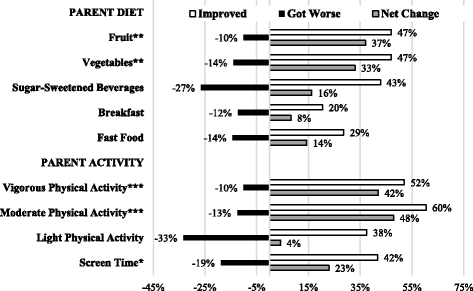ANDALE Pittsburgh: results of a promotora-led, home-based intervention to promote a healthy weight in Latino preschool children
- PMID: 29548321
- PMCID: PMC5857096
- DOI: 10.1186/s12889-018-5266-3
ANDALE Pittsburgh: results of a promotora-led, home-based intervention to promote a healthy weight in Latino preschool children
Abstract
Background: Latino preschool children have higher rates of obesity than preschool children from other racial/ethnic groups; however, few effective, culturally appropriate interventions exist targeting this group. The purpose of this study was to test the feasibility of a 10-week, promotora-mediated, home-based intervention to promote a healthy weight in Latino preschool children.
Methods: Trained promotoras (community health workers) delivered 10, 90-min weekly interactive and tailored sessions to Latino families living in Allegheny County. Participants were recruited through promotoras' own social networks and community gatherings, flyers, and word of mouth. Primary outcome measures included child body mass index (BMI) z-score and percentile. Secondary outcome measures included child objectively measured physical activity and dietary intake, and the home social and physical environment (e.g., parent health behaviors, parent self-efficacy, parental support, physical activity equipment in the home). The final analysis sample included 49 of 51 participants who completed both baseline and follow-up assessments.
Results: Participants included mothers (33.5 ± 6.1 years old) and their preschool-aged children who were primarily 1st generation immigrants from Mexico (65%). The primary analyses of BMI percentile and z-score showed no change post-intervention. However, there was a significant decrease in child BMI percentile for overweight and obese children from baseline to follow-up (p < .05). We also saw significant pre/post increases in child daily fruit and vegetable intake, and parent moderate-to-vigorous physical activity, fruit and vegetable servings per day, and self-efficacy; and significant decreases in child saturated fat and added-sugar intake, and child and parent screen time (p's < .05).
Conclusions: Despite the short duration of the intervention and follow-up, this pilot study showed promising effects of a promotora-mediated intervention to promote a healthy weight in Latino preschool children.
Keywords: Childhood obesity; Community health worker; Hispanic/Latino; Intervention; Preschool.
Conflict of interest statement
Ethics approval and consent to participate
The Institutional Review Board at the University of Pittsburgh approved all study protocols. Written, informed parental consent was obtained for children participating in this study, and that written, informed consent was obtained from all participants over the age of 18 years old.
Consent for publication
Not applicable.
Competing interests
The authors declare that they have no competing interests.
Publisher’s Note
Springer Nature remains neutral with regard to jurisdictional claims in published maps and institutional affiliations.
Figures

Similar articles
-
Implementation Monitoring of a Promotora-Led, Home-Based Obesity Prevention Pilot Study With Latino Preschool Children and Their Mothers.Int Q Community Health Educ. 2021 Jul;41(4):411-418. doi: 10.1177/0272684X20970375. Epub 2020 Nov 3. Int Q Community Health Educ. 2021. PMID: 33143559 Free PMC article.
-
"She Gave Me the Confidence to Open Up": Bridging Communication by Promotoras in a Childhood Obesity Intervention for Latino Families.Health Educ Behav. 2017 Oct;44(5):728-737. doi: 10.1177/1090198117727323. Epub 2017 Aug 30. Health Educ Behav. 2017. PMID: 28851237 Clinical Trial.
-
Active and Healthy Families: A Randomized Controlled Trial of a Culturally Tailored Obesity Intervention for Latino Children.Acad Pediatr. 2015 Jul-Aug;15(4):386-95. doi: 10.1016/j.acap.2015.02.004. Epub 2015 Apr 28. Acad Pediatr. 2015. PMID: 25937516 Clinical Trial.
-
Home Environmental Influences on Childhood Obesity in the Latino Population: A Decade Review of Literature.J Immigr Minor Health. 2017 Apr;19(2):430-447. doi: 10.1007/s10903-016-0539-3. J Immigr Minor Health. 2017. PMID: 28005241 Free PMC article. Review.
-
Impact of Parent Engagement in Childhood Obesity Prevention Interventions on Anthropometric Indices among Preschool Children: A Systematic Review.Child Obes. 2020 Jan;16(1):3-19. doi: 10.1089/chi.2019.0103. Epub 2019 Sep 3. Child Obes. 2020. PMID: 31479311
Cited by
-
Training Promotoras to Implement a Mindfulness-Based Healthy Lifestyle Program in Rural Communities.J Nutr Educ Behav. 2024 Jun;56(6):406-412. doi: 10.1016/j.jneb.2024.02.006. Epub 2024 Mar 22. J Nutr Educ Behav. 2024. PMID: 38520425 Free PMC article.
-
Control and Chaos: Caregiver's Basic Psychological Need Frustration is Associated With the Socioemotional Climate When Feeding.J Nutr Educ Behav. 2023 May;55(5):363-370. doi: 10.1016/j.jneb.2023.02.002. Epub 2023 Mar 8. J Nutr Educ Behav. 2023. PMID: 36898869 Free PMC article.
-
Profiles of Cultural Adaptation and Parenting Approach for Childhood Obesity in Lifestyle Interventions for Families With Young Children: A Systematic Review.Fam Community Health. 2024 Apr-Jun 01;47(2):95-107. doi: 10.1097/FCH.0000000000000397. Fam Community Health. 2024. PMID: 38372327 Free PMC article.
-
Acceptability and appropriateness of a novel parent-staff co-leadership model for childhood obesity prevention in Head Start: a qualitative interview study.BMC Public Health. 2021 Jan 22;21(1):201. doi: 10.1186/s12889-021-10159-3. BMC Public Health. 2021. PMID: 33482774 Free PMC article.
-
Family-based interventions for preventing overweight or obesity among preschoolers from racial/ethnic minority groups: A scoping review.Obes Sci Pract. 2021 Dec 10;8(3):371-386. doi: 10.1002/osp4.578. eCollection 2022 Jun. Obes Sci Pract. 2021. PMID: 35664252 Free PMC article.
References
-
- Woods T, Hanson D. Immigrant Children. Washington, DC: Urban Institute; 2016. Demographic trends of children of immigrants; pp. 1–8.
-
- Hernandez DJ, Denton NA, Macartney SE. Children in immigrant families: looking to America's future. Social Policy Report. 2008;21:3–22.
-
- Ogden C, Carroll M, Fryar C, Flegal K. Prevalence of obesity among adults and youth: United States, 2011–2014. NCHS data brief 2015(219):1–8. - PubMed
Publication types
MeSH terms
Grants and funding
LinkOut - more resources
Full Text Sources
Other Literature Sources
Medical

